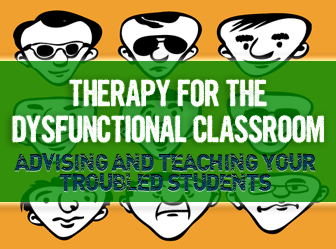This Class ####%!$ Stinks! Relating to Students Who Show Blatant Disrespect


It’s no secret that many ESL students are troubled individuals, having experienced trauma in their home countries. In addition, the immigration process itself is often a source of trauma as students and their families try, with varying degrees of success, to adjust to their new culture. These anxieties often get played out in an ESL classroom, where troubled students might come into contact with other similarly troubled students.

Dysfunctional behavior and ways of relating to one another are, in my experience, universal, with negative patterns occurring across cultures and genders rather than being associated with any specific one. Some of the types you may see are the following:
“Dependent” seems to be the operant part of the term, with the student viewing the teacher as a parent figure. This isn’t necessarily bad, to an extent. A student last term, for example, told me she saw me as a “second mom,” which I found flattering, not a cause for concern, for the student, very new to U.S. culture, simply accepted—and then applied-- some pointers for getting along in an American college. It’s when students solicit help but then ignore it yet keep coming back for more that the problem arises. This may be called “codependent” behavior, when both parties are locked in a dysfunctional pattern of continually helping and requesting help. A teacher’s job is in fact to help—but ultimately to help students toward independence. It is tricky to balance helping yet not helping too much, but it can be done by limiting the amount of help given to the same student. If he always comes to class unprepared, for example, the teacher should stop lending out paper, pens, dictionaries, the text, etc., which will teach the student to bring his own materials.
Mr. Passive Aggressive goes through the course syllabus thoroughly, looking for loopholes to wiggle through. If the syllabus says students may be absent “up to three times,” he is absent two times then asks if “up to three” includes a third time or really means only two. He sleeps in class. He turns in papers with extra-large font, a title page, pictures, and an extensive bibliography to get to the required page count.
Since Mr. Passive Aggressive seems to thrive on exploiting the ambiguous, make materials as clear as possible: “A thousand words means a thousand words, Mr. Passive Aggressive. No more nor less.” You may also call the passive aggressive behavior what it is: “Sleeping in class seems rude. Can you explain to me why you do it?” Because direct questions bother Mr. Passive Aggressive, he will likely stop the behavior.
The gloves are off with Ms. Antisocial. There is nothing passive about her aggressive: she is loud and belligerent in challenging the teacher and her peers. Sometimes other students are frightened of and avoid working with her groups, which is fine with her—she’d rather sit alone and glower or carry on angry cell phone conversations, anyway. Sometimes the antisocial behavior carries over into course writing—essays or journals, in which the student recounts aggressive encounters with others.
Dealing with the. anti-social student requires care. Once, with a student whose journals were his venting of anger with his girlfriend, his best friend, his mother, etc., I scrawled a note that he might benefit from therapy and didn’t think I was at all out of line. In other cases, I’ve pulled aggressive students aside and simply asked for more cooperation in class. Usually students will comply—never becoming the most popular classmate, but at least getting along with their peers well enough for the duration of the course.
You know this type of shrinking violet. Mr. Oh-So-Shy won’t open his mouth in class and has to be almost dragged into group work. His eyes are usually on his book or an electronic device.
Gentle insistence with the shy type is most effective: he must put away his electronics and books, join a group, and participate. Since Mr. Oh-So-Shy is not usually antisocial, just shy, finding a classmate he can relate to also helps him relax and participate.

The good news is almost never do all of these dysfunctional types turn up in one class. The bad news is it can take only one to ruin a class. How do you keep him or her from doing that?
The teacher sets the tone that she wants from the beginning through the course syllabus and on how she treats the students: friendly yet professional.
Group norms, the acceptable and unacceptable behavior for the class, can be established in a list. If you find text-messaging unacceptable during group work, state so in the list. Have students add their own norms for the class or for their groups.
Keep your cool with students, and don’t lose your temper even with the most exasperating student. This relates to establishing the norms—if it is an expectation that students always treat each other with kindness and respect, the teacher is responsible for modeling this value.
Sometimes the teacher “losing it” is an effective technique. The trick is that this is really a strategy, and the teacher who appears to have lost his temper is still in control of the situation. The point of “blowing your cool” with students is to reaffirm “this is not how we act” in an extreme violation of the group norms.
After your brief tirade, or mild scolding, or earnest discussion, however you choose to handle the departure from the norm, be sure to reaffirm the norms. For example, a high school teacher I know who found a group of his students had defaced the halls with graffiti stalked into class and treated the abashed students to a stern lecture about how disappointed he was, that they were nothing more than gang members in the making; the instigators would be smoked out and the authority notified, etc. His ending comments, however, returned to the group norms: “This is not how civilized people act, and it is not, specifically, how we act at this school.” The point of such a tirade is ultimately not to intimidate the students but rather to draw a stark line between what is acceptable and unacceptable behavior and is effective only when the teacher is by contrast usually calm.
ESL classes attract more than their share of troubled students who should be treated with care while being gently guided to the behavior expected in an American university.
Who are your troubled students? How do you treat them?